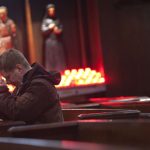While the Moonbat never quite made it out of the prototype stage, the aircraft marked a promising beginning for the now-storied aerospace manufacturer.
In 1940, the Army Air Corps issued Request for Proposal (RFP) R-40C. The wartime RFP asked aerospace manufacturers for a fast, high-flying, long-range interceptor that could counter enemy bombers. Twenty-three companies submitted designs to meet the RFP. Among them was a brand new aerospace parts manufacturer that was keen to make its own aircraft—McDonnell Aircraft.
The McDonnell submission was bold, with a novel drive train and distinctive features. The aircraft, designated the XP-67 Bat (or alternatively, “Moonbat”), was conceptually advanced. Yet the plane failed to perform. Only one prototype was ever developed, and it was destroyed after the engine caught fire.
Predictably, then, the XP-67 did not win the RFP contract. Still, the Air Corps was impressed with the nascent company, keeping them in mind for future projects—and McDonnell would go on to design the Mercury and Gemini space capsules, before being absorbed into major defense contractor McDonnell Douglas in 1967.
McDonnell’s Highly Unconventional Plane
McDonnell worked through various designs when creating the Moonbat, ultimately settling on a rather ambitious, somewhat futuristic looking final design. Early designs called for a single-engine, but the finished prototype featured twin-engines (Continental XI-1430-1 V-12s with turbo-superchargers), which powered four-bladed propellers, mounted in a tractor configuration in front of each wing.
Other elements of the design were quite ambitious, with the rear portions of the engine nacelles merged with the wing. Notably, each edge of the aircraft was filleted, or rounded, in an effort to reduce drag. The aircraft had laminar-flow characteristics, which required new construction techniques. The result is visually distinct—in that the Moonbat’s entire airframe looks uniquely smooth and, for the 1940s, futuristic. McDonnell estimated that the aircraft would be able to fly at top speeds of 472 miles per hour, outstripping comparable aircraft such as the P-38 Lightning and P-51 Mustang.
Testing the Moonbat
Before the Moonbat was ever taken to the skies, she was tested in a wind tunnel, where early tests revealed a tendency for engine cooling airflow to move through the engine nacelles. This problem was never fully resolved, but deemed minor enough to allow the Moonbat to undergo ground trials. Shortly thereafter, however, the aircraft suffered its first fire, which a malfunction in the exhaust manifold slip rings caused, and which damaged both engine nacelles. The damage was repairable, and the Moonbat was nursed back to health.
One month after the fire, in early 1944, the Moonbat made its first flight. The flight lasted just six minutes on account of engine problems. The engines were tinkered with, and testing continued. However, with the Moonbat in the air, one thing became quickly evident: the aircraft lacked power. The engines, which were supposed to deliver 1,300 horsepower each, managed just 1,060 horsepower. The lack of power manifested in a slow rate of climb, slow acceleration, and a long takeoff roll.
The Moonbat did have some satisfactory flight characteristics. The aircraft enjoyed a light stick, decent roll rate, and a measure of control that pilots complimented. Yet there were problems, too. Notably, the Moonbat would begin to buffet as it approached the airplane’s stall speed. Generally, the pilots were concerned with the Moonbat’s poor maneuverability at slow speeds.
In September of 1944, a fire during a test flight gutted the lone Moonbat prototype. Given the Moonbat’s performance problems before the fire, the Air Corps decided not to rebuild the aircraft and instead, cancel the program. And while the Moonbat never quite made it out of the prototype stage, the aircraft marked a promising beginning for the now-storied aerospace manufacturer.
About the Author: Harrison Kass
Harrison Kass is a senior defense and national security writer with over 1,000 total pieces on issues involving global affairs. An attorney, pilot, guitarist, and minor pro hockey player, Harrison joined the US Air Force as a Pilot Trainee but was medically discharged. Harrison holds a BA from Lake Forest College, a JD from the University of Oregon, and an MA from New York University. Harrison listens to Dokken.
Image: Wikimedia Commons.


















